Correlation between the Flow and Curing Behavior of Hard Magnetic Fillers in Thermosets and the Magnetic Properties
Abstract
:1. Introduction
1.1. Magnetic Properties
1.2. Injection Molding
1.3. Flow Behavior and Reaction Kinetics of Thermosets
1.4. Aim of the Paper
2. Materials and Methods
2.1. Material
2.2. Fabrication of the Test Specimens
2.2.1. Preparation for Material Characterization
2.2.2. Preparation for Magnetic Characterization
2.3. Characterization
2.3.1. Particle Size Distribution
2.3.2. Differential Scanning Calorimetry (DSC) following DIN EN ISO 11357
2.3.3. Flow Behavior of Powdered Compound
2.3.4. Specific Heat Capacity c and Thermal Conductivity λ of Pure Filler Material and Compounds
2.3.5. Flow and Curing Behavior
2.3.6. Scanning Electron Microscope
2.3.7. Magnetic Properties
3. Results and Discussion
3.1. Particle Size Distribution
3.2. Differential Scanning Calorimetry (DSC)
3.3. Flow Behavior of Powdered Compound
3.4. Specific Heat Capacity c and Thermal Conductivity λ of Pure Filler Material and Compounds
3.5. Flow Behavior
3.6. Curing Behavior and Process Stability
3.7. Particle Surface and Distribution in the Compound
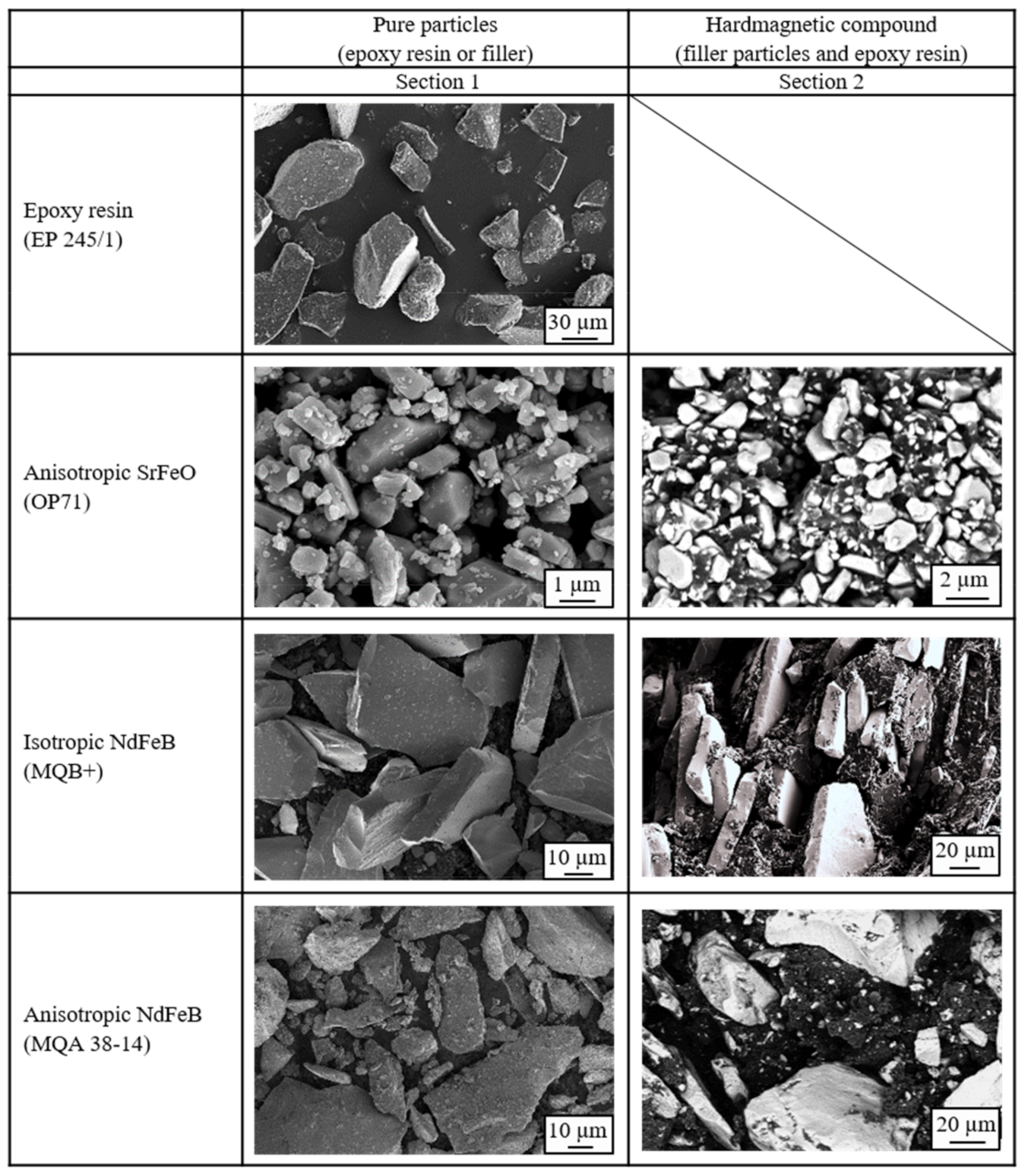
3.8. Magnetic Properties
3.9. Correlation between the Influencing Factors of the Flow and Curing Behavior
4. Conclusions
Author Contributions
Funding
Data Availability Statement
Acknowledgments
Conflicts of Interest
References
- Drummer, D. Prozessführung beim Spritzgießen kunststoffgebundener Dauermagnete. In Kunststoffgebundene Dauermagnete; Springer: Düsseldorf, Germany, 2004. [Google Scholar]
- Hagemann, B. Kunststoffgebundene Magnete in der Antriebstechnik—Möglichkeiten und Grenzen. In Kunststoffgebundene Dauermagnete; Springer: Düsseldorf, Germany, 2004. [Google Scholar]
- Sadovnikov, A.V.; Odintsov, S.A.; Beginin, E.N.; Grachev, A.A.; Gubanov, V.A.; Sheshukova, S.E.; Sharaevskii, Y.P.; Nikitov, S.A. Nonlinear Spin Wave Effects in the System of Lateral Magnonic Structures. JETP Lett. 2018, 107. [Google Scholar] [CrossRef]
- Schliesch, T. Sensormagnete: Vielfältig gestaltbare Spritzgussteile: Magnete mit virtuoser Polverteilung. Industrieanzeiger, 7 June 2010; p. 20. [Google Scholar]
- Johannaber, F.; Michaeli, W. Handbuch Spritzgießen, 2nd ed.; Carl Hanser Verlag: München, Germany, 2004. [Google Scholar]
- Ormerod, J.; Constantinides, S. Bonded permanent magnets: Current status and future opportunities (invited). J. Appl. Phys. 1997, 81, 4816–4820. [Google Scholar] [CrossRef] [Green Version]
- Inaguma, T.; Sakamoto, H.; Mukai, T. Magnetic properties of resin-bonded magnets of anisotropic Nd-Fe-B-Cu powder. IEEE Transl. J. Magn. Jpn. 1993, 8, 27–32. [Google Scholar] [CrossRef]
- Reppel, G.W. Duroplastgepresste Magnete—Werkstoffe, Verfahren und Eigenschaften. In Kunststoffgebundene Dauermagnete; Springer: Düsseldorf, Germany, 2004; pp. 14–36. [Google Scholar]
- Lagorce, L.; Allen, M. Magnetic and mechanical properties of micromachined strontium ferrite/polyimide composites. J. Microelectromechanical Syst. 1997, 6, 307–312. [Google Scholar] [CrossRef] [Green Version]
- MS Schramberg GmbH & Co. KG. Umfassend; MS Schramberg GmbH & Co.: Schramberg, Germany, 2010. [Google Scholar]
- Kurth, K.H.; Drummer, D. Influences of the Magnetic Properties of Injection Molded Multipolar Rings. Int. Polym. Process. 2016, 31, 356–363. [Google Scholar] [CrossRef]
- Baur, E.; Brinkmann, S.; Osswald, T.; Rudoplh, N.; Schmachtenberg, E. Saechtling Kunststoff Taschenbuch, 31st ed.; Carl Hanser Verlag: München, Germany, 2013. [Google Scholar]
- Glöser-Chahoud, S.; Kühn, A.; Espinoza, L.A.T. Flobale Verwendungsstrukturen der Magnetwerkstoffe Neodym und Dysprosium: Eine szenariobasierte Analyse der Auswirkung der Diffusion der Elektromobilität auf den Bedarf an Seltenen Erden; Working Paper Sustainability and Innovation; Fraunhofer ISI: Karlsruhe, Germany, 2016. [Google Scholar]
- Rösel, U.; Drummer, D. Injection Moulding of Multipolar Polymer-Bonded Magnets into Soft Magnetic Inserts for Rotors in Reluctance Motors. Magnetism 2021, 1, 2. [Google Scholar] [CrossRef]
- Baran, W. Magnetische Werkstoffe für Energiewandler und Statistische Systeme. In Magnetische Werkstoffe; Verlag TÜV: Rheinland, Germany, 1990. [Google Scholar]
- Michalowsky, L. Magnettechnik: Grundlagen, Werkstoffe, Anwendungen, 3rd ed.; Vulkan-Verl.: Essen, Germany, 2006. [Google Scholar]
- Wellmann, P. Materialien der Elektronik und Energietechnik: Halbleiter, Graphen, Funktionale Materialien; Springer Fachmedien Wiesbaden: Wiesbaden, Germany, 2017. [Google Scholar]
- Cassing, W.; Seitz, D. Dauermagnete: Mess und Magnetisierungstechnik, 2nd ed.; Expert-Verl.: Renningen, Germany, 2015. [Google Scholar]
- Hering, E.; Martin, R.; Stohrer, M. Physik für Ingenieure, 12th ed.; Springer Vieweg: Berlin/Heidelberg, Germany, 2016. [Google Scholar]
- Koch, J. Dauermagentische Werkstoffe und ihre Anwendungen. Phys. Blätter 1975, 31, 439–455. [Google Scholar] [CrossRef]
- Ma, B.; Sun, A.; Gao, X.; Bao, X.; Li, J.; Lang, H. Preparation of anisotropic bonded NdFeB/SmFeN hybrid magnets by mixing two powders. J. Magn. Magn. Mater. 2018, 457, 70–74. [Google Scholar] [CrossRef]
- Drummer, D. Verarbeitung und Eigenschaften Kunststoffgebundener. Dauermagnete. Dissertation, University of Erlangen-Nuremberg, Erlangen, Germany, 2004. [Google Scholar]
- Stitz, S. Spritzgießtechnik: Verarbeitung, Maschine, Peripherie, 2nd ed.; Hanser: München, Germany, 2004. [Google Scholar]
- Kurth, K.; Drummer, D. Variation of the Pole Length in Pole-Oriented Bonded Rings due to the Location and Number of Injection Points. J. Polym. 2017, 2017, 1–11. [Google Scholar] [CrossRef] [Green Version]
- Hoven-Nievelstein, W. Wir bewegen uns in Richtung Spezialitäten. Kunststoffe—Werkstoffe Verarbeitung Anwendung 2008, 6, 24–29. [Google Scholar]
- Altmann, N.; Halley, P.J.; Cooper-White, J.; Lange, J. The Effects of Slica Fillers on the Gelation and Viltrification of Highly Filled Epoxy-Amine Thermosets. In Macromolecular Symposia; WILEY-VCH Verlag GmbH: Weinheim, Germany, 2001; Volume 169, pp. 171–177. [Google Scholar]
- Bae, J.; Jang, J.; Yoon, S.-H. Cure Behavior of the Liquid-crystalline Epoxy/Carbon Nanotube System and the Effect of surface treatment of carbon fillers on cure reaction. Macromol. Chem. Phys. 2002, 203, 2196. [Google Scholar] [CrossRef]
- Dutta, A.; Ryan, M. Effect of fillers on kinetics of epoxy cure. J. Appl. Polym. Sci. 1979, 24, 635–649. [Google Scholar] [CrossRef]
- Wang, X.; Jin, J.; Song, M.; Lin, Y. Effect of graphene oxide sheet size on the curing kinetics and thermal stability of epoxy resins. Mater. Res. Express 2016, 3, 105303. [Google Scholar] [CrossRef] [Green Version]
- Halley, P.J. A new chemorheological analysis of highly filled thermosets used in integrated circuit packaging. J. Appl. Polym. Sci. 1997, 64, 95–106. [Google Scholar] [CrossRef]
- Altmann, N.; Halley, P.J. The effect of follers on the chemorheology of highly filled eopxy resin: I. Effects on cure transitions and kinetics. Polym. Int. 2003, 52, 113–119. [Google Scholar] [CrossRef]
- Zhao, Z.; Zhanyu, Z.; Drummer, D. Thermal conductivity of alumininosilicate and aluminium oxide filled thermosets for injection molding. Polymers 2018, 10, 457. [Google Scholar] [CrossRef] [Green Version]
- Zhao, Y.; Drummer, D. Influence of filler content and filler size on the curing kinetics of an epoxy resin. Polymers 2019, 11, 1797. [Google Scholar] [CrossRef] [PubMed] [Green Version]
- Yushanov, S.P.; Isayev, A.I.; Levin, V.Y. Perolation simulation of the network degradation during ultrasonic devulcanization. J. Polym. Sci. Part B Polym. Phys. 1996, 34, 2409–2418. [Google Scholar] [CrossRef]
- Maenz, T.; Hülder, G.; Gehde, M. Influence of flow behavor of different matrix materials on the orientation of anisotropic magnetic particles during injection molding. AIP Conf. Proc. 2016, 1779, 20011. [Google Scholar]
- Ehrenstein, G.W.; Riedel, G.; Trawiel, P. Praxis der Thermischen Analyse von Kunststoffen, 2nd ed.; Carl Hanser Verlag: München, Germany, 2003. [Google Scholar]
- Kummer Semicondutor Technology. Aushärtung von Epoxidharzen und Glasübergangstemperatur (Tg). 2020. Available online: https://www.jpkummer.com/sites/default/files/Aushärtung%20von%20Epoxidharzen%20und%20Glasübergangstemperatur%20%28Tg%29.pdf#:~:text=Hier%20ist%20ein%20DSC%20H%C3%A4rtungsprofil%20eines%20typischen%20Epoxidsystems,schnellste%20H%C3%A4rtung%20dieses%20Produktes%20bei%20dieser%20Temperatur%20erfolgt (accessed on 26 November 2021).
- Schmid, M. Selektives Lasersintern (SLS) mit Kunststoffen: Technologie, Prozesse und Werkstoffe; Hanser: München, Germany, 2015. [Google Scholar]
- Brabender, Brabender Messkneter: Für Materialentwicklung und Qualitätskontrolle; Brabender® GmbH & Co: Duisburg, Germany, 2017.
- Huang, X.; Iizuka, T.; Jiang, P.; Ohki, Y.; Tanaka, T. Role of Interface on the Thermal Conductivitiy of Highly Filled Dielectric Epoxy/AlN Composites. J. Phys. Chem. C 2012, 116, 13629–13639. [Google Scholar] [CrossRef]
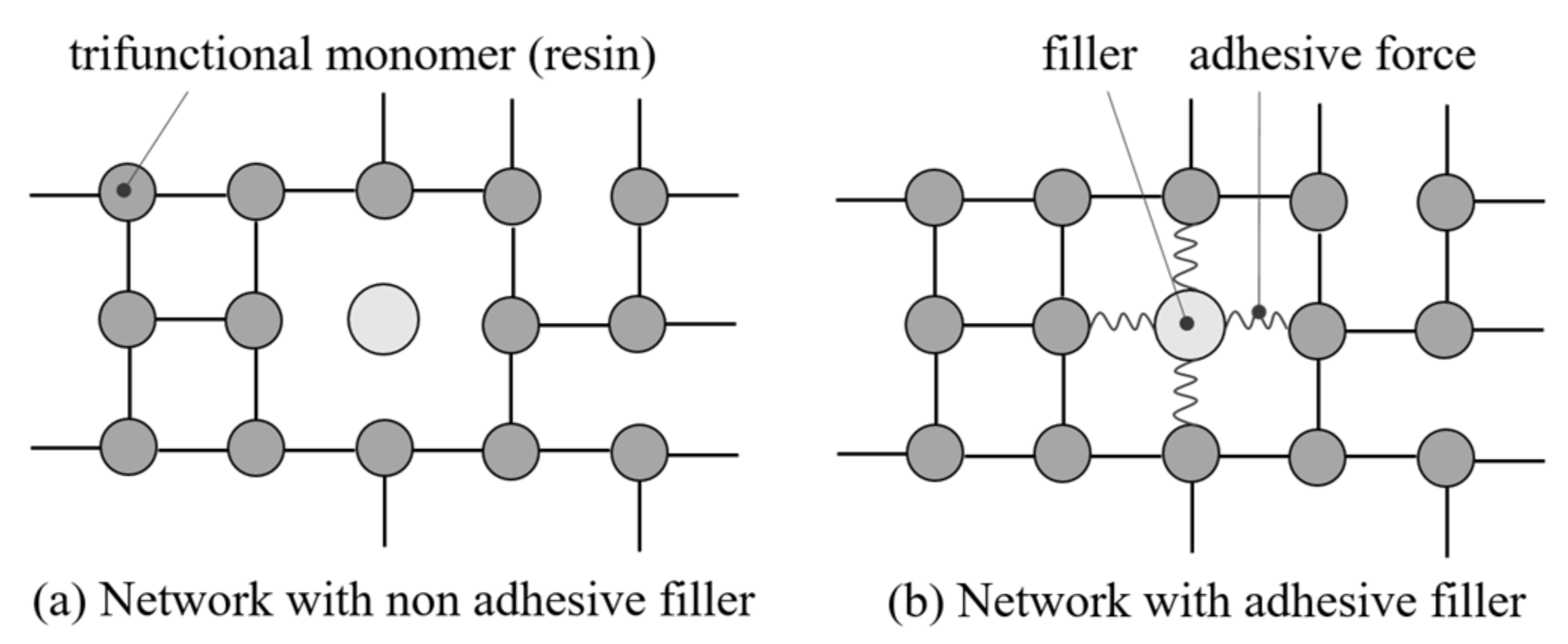
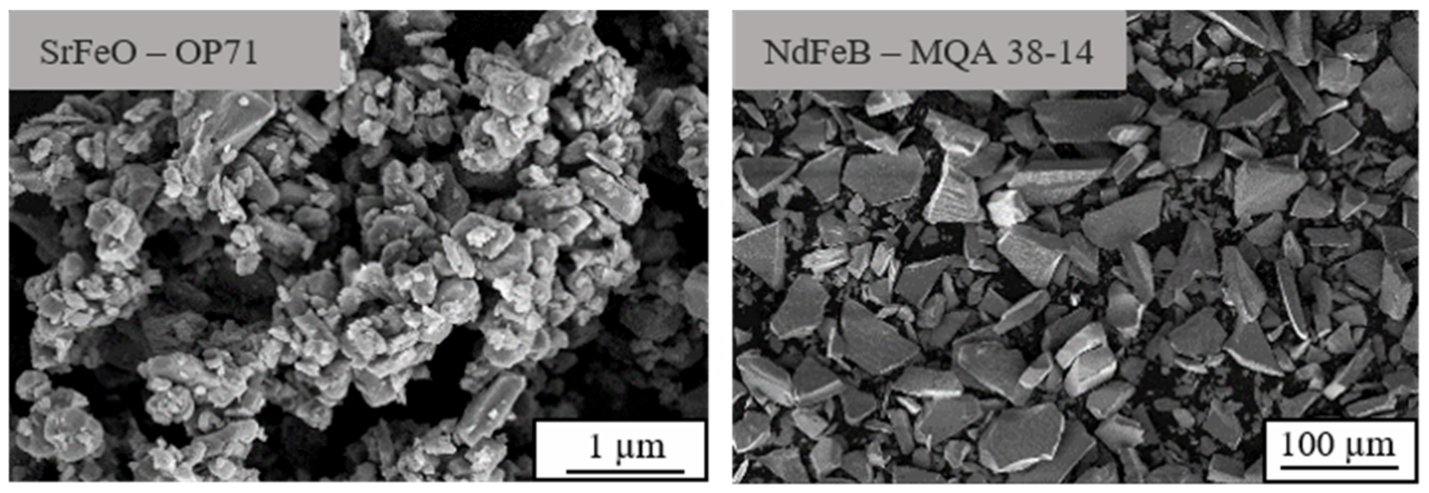
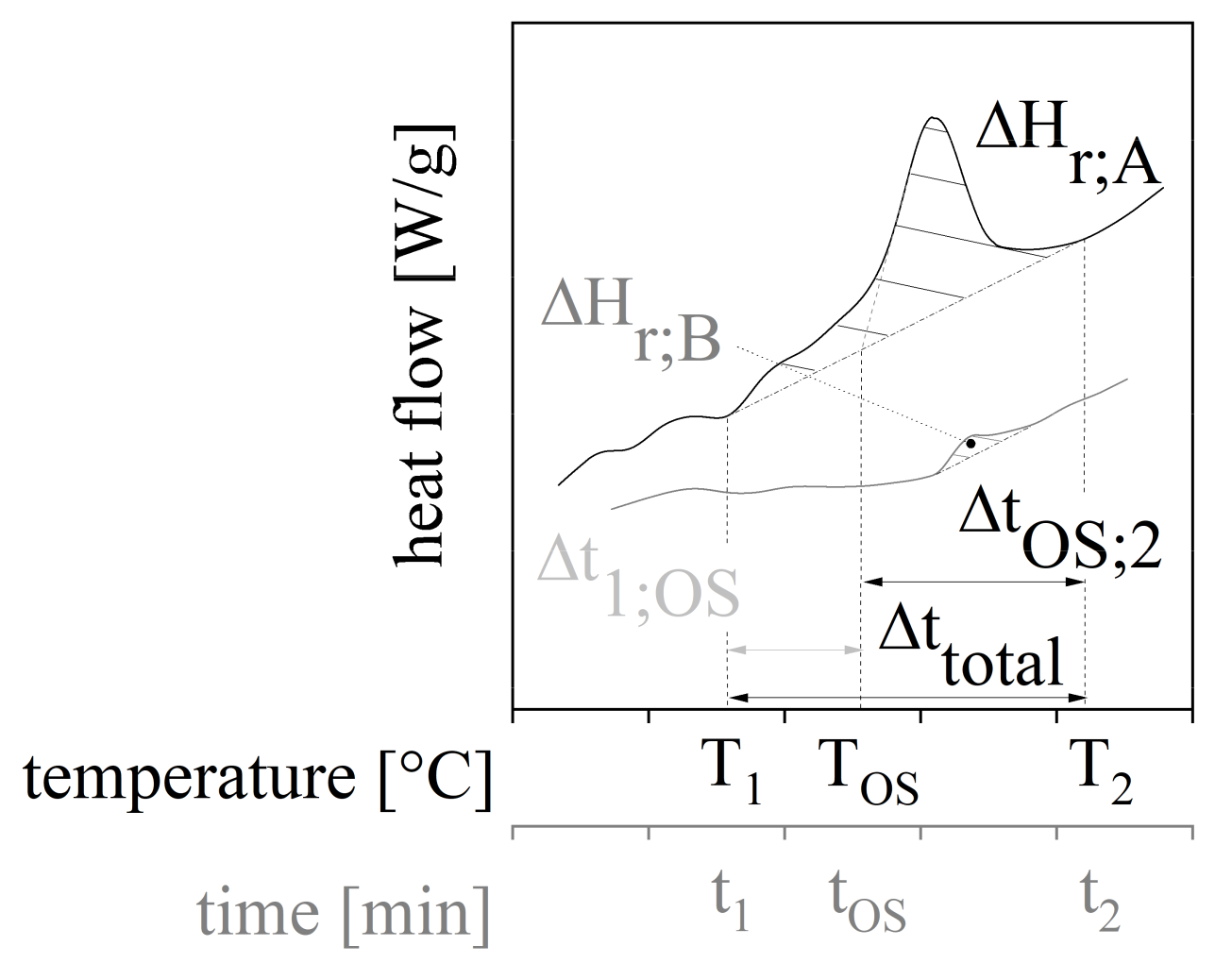
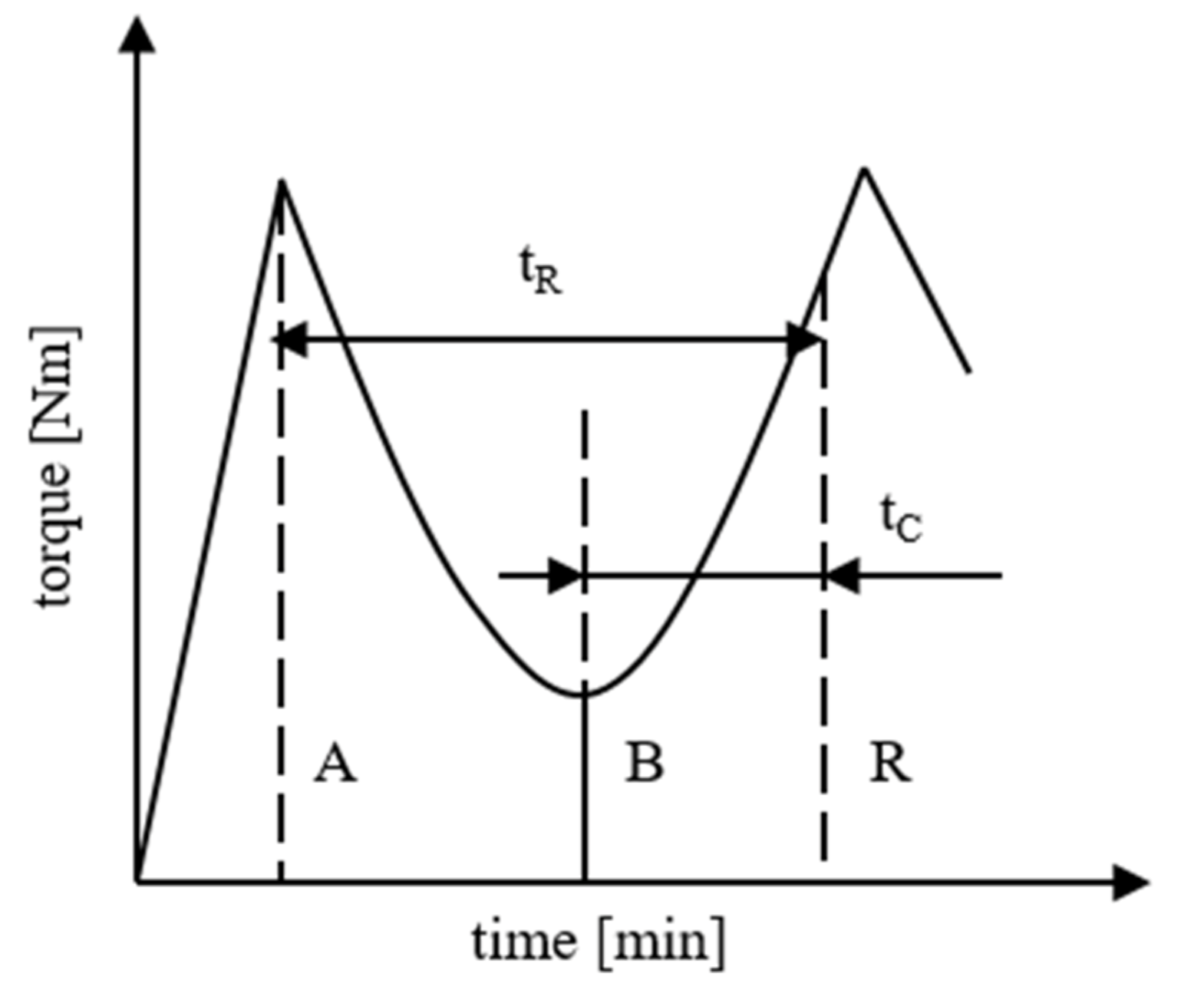
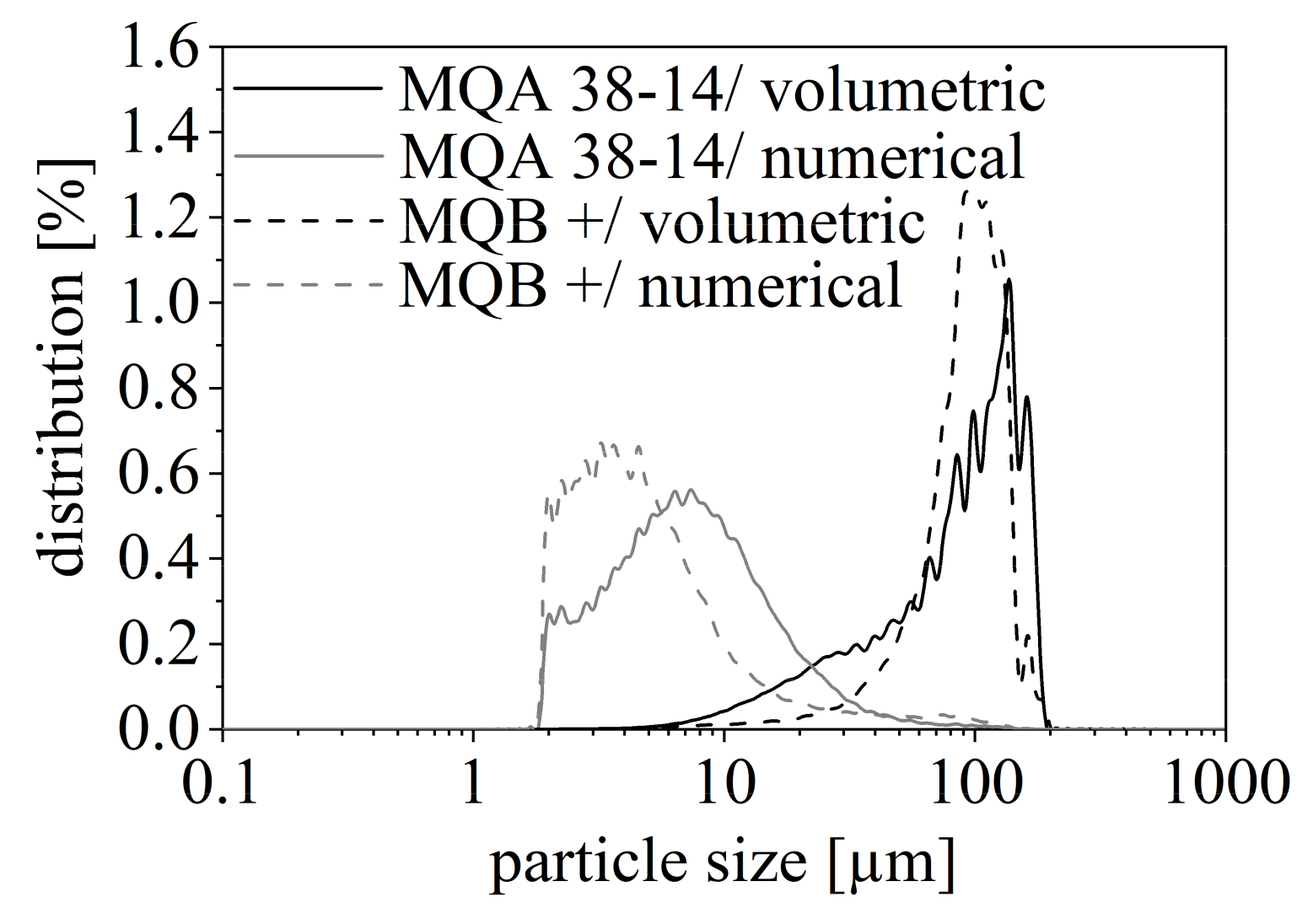
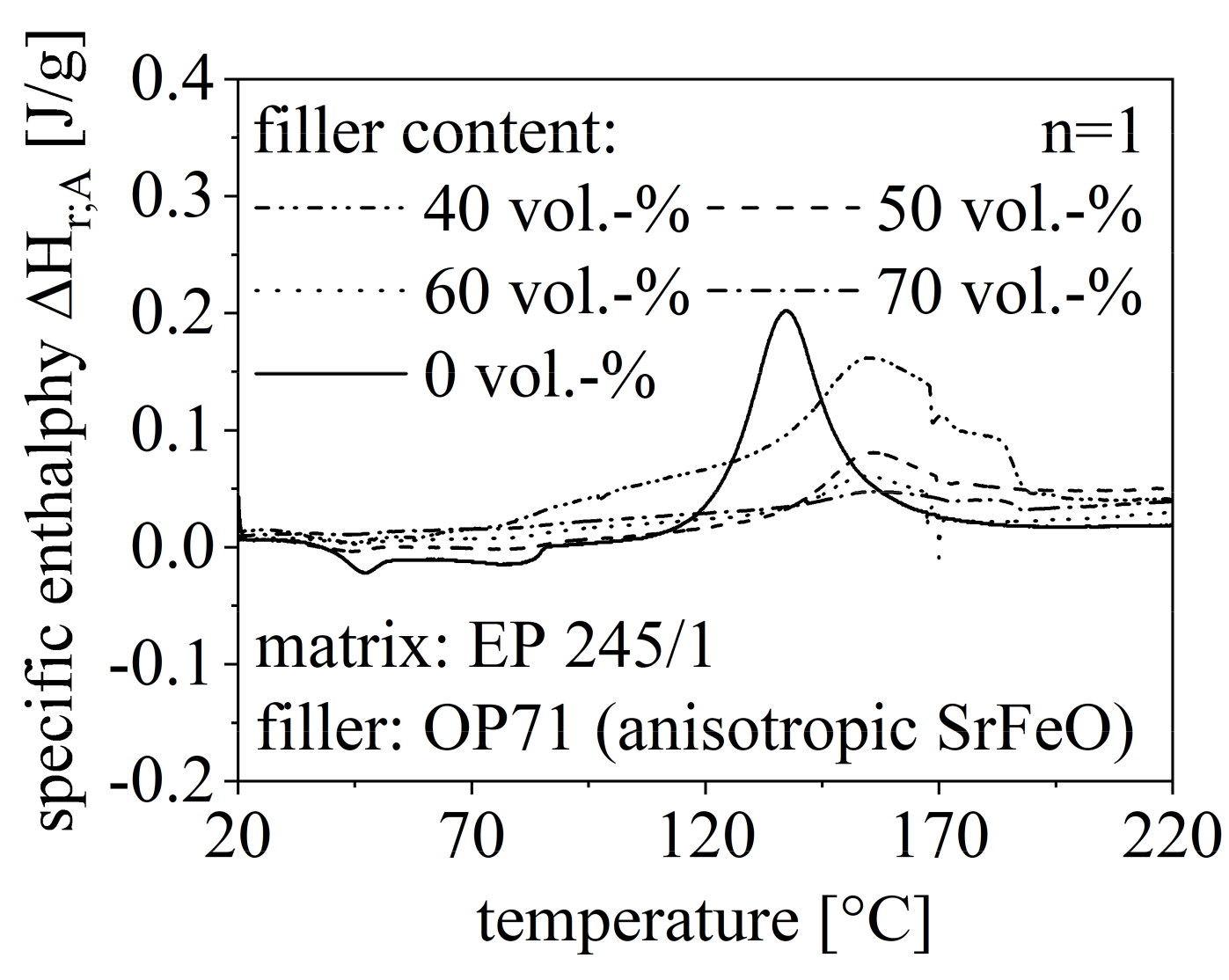


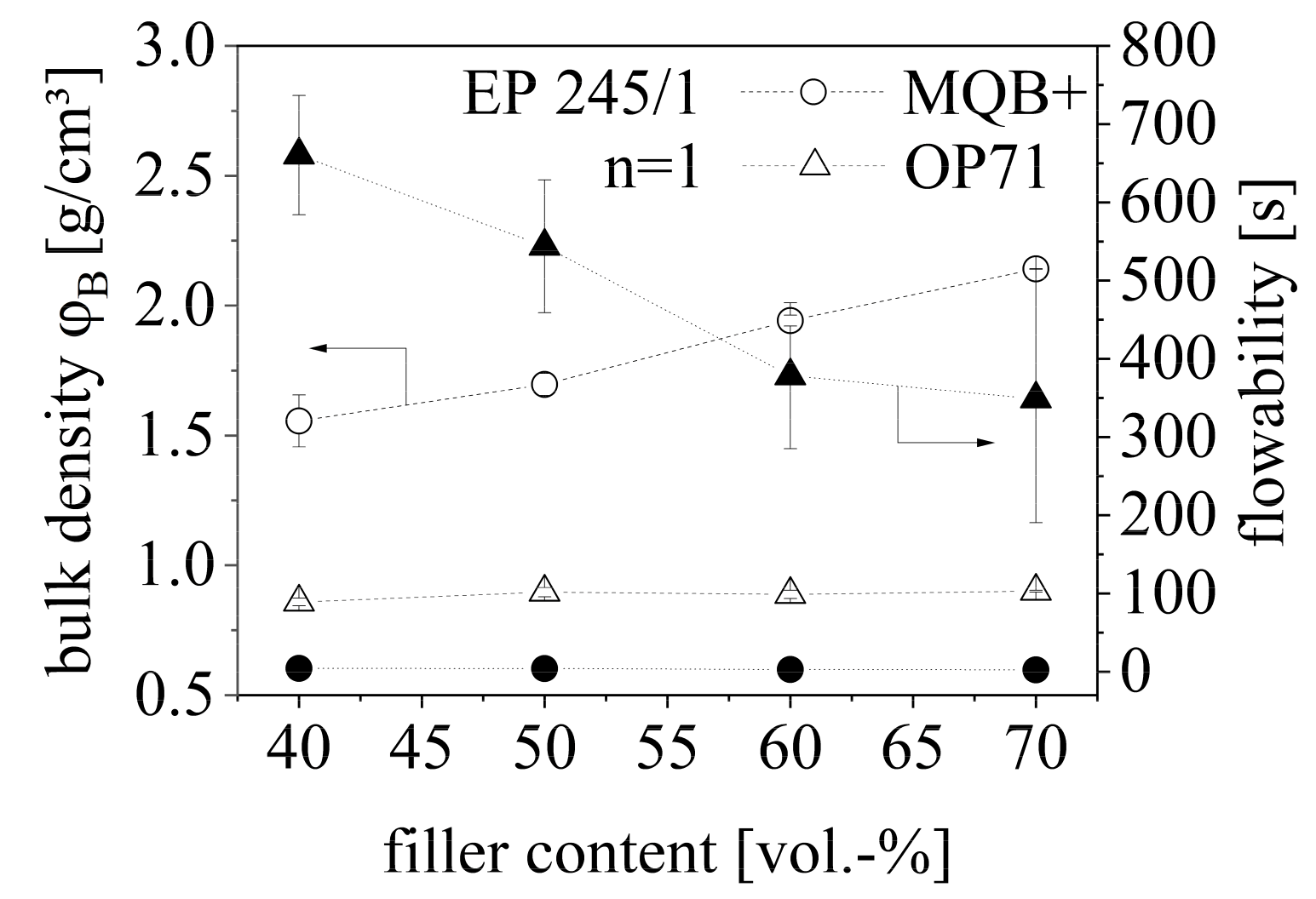
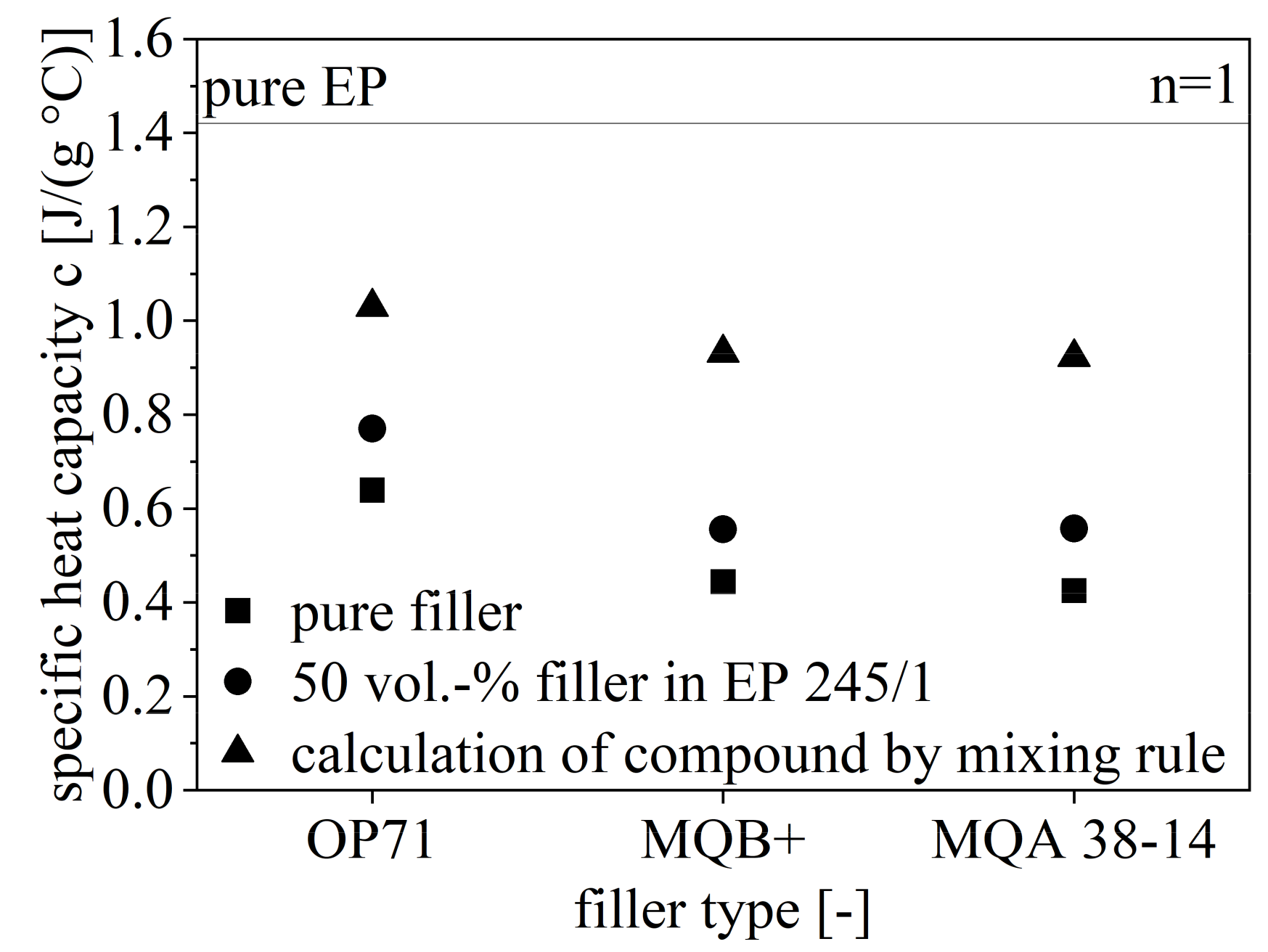
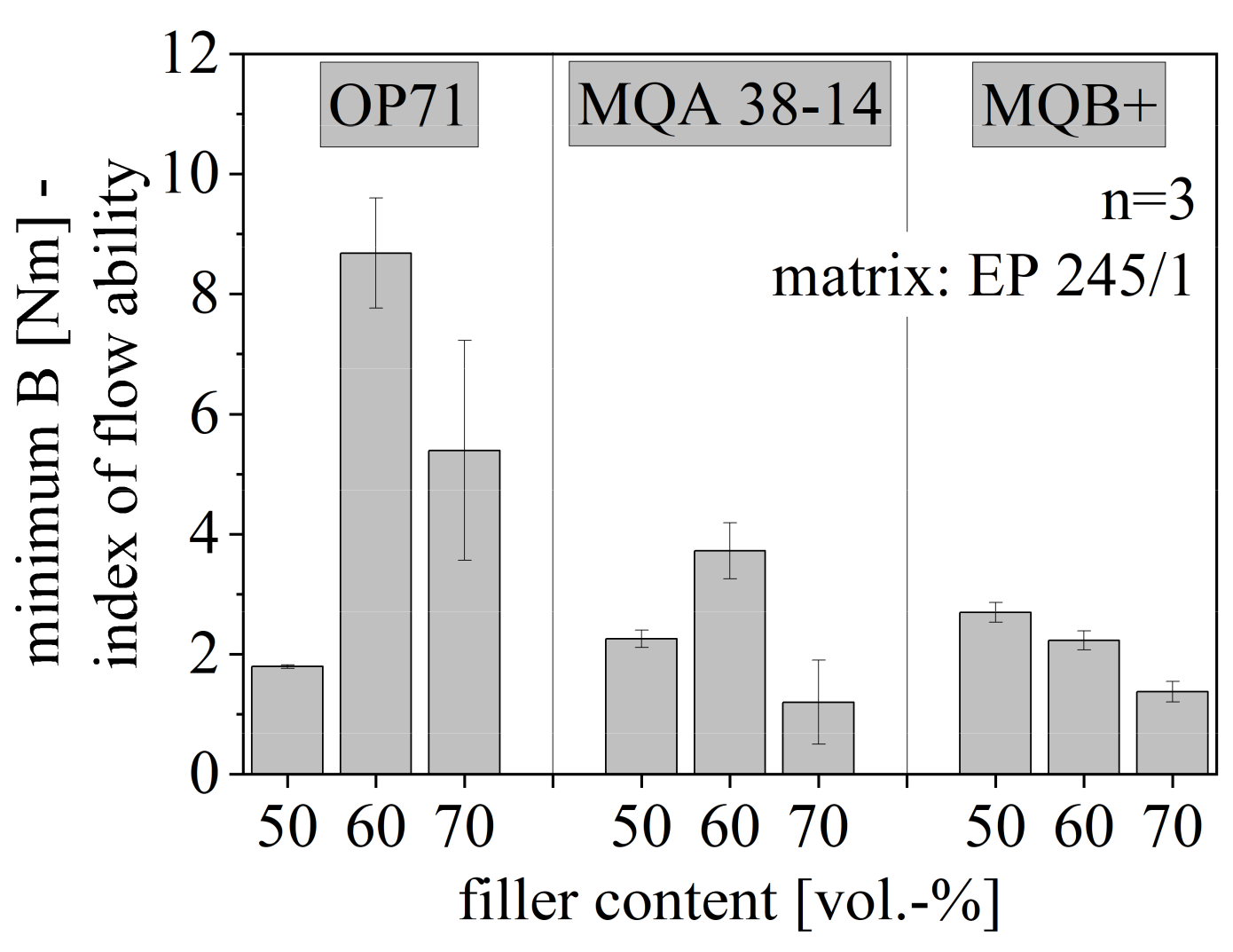


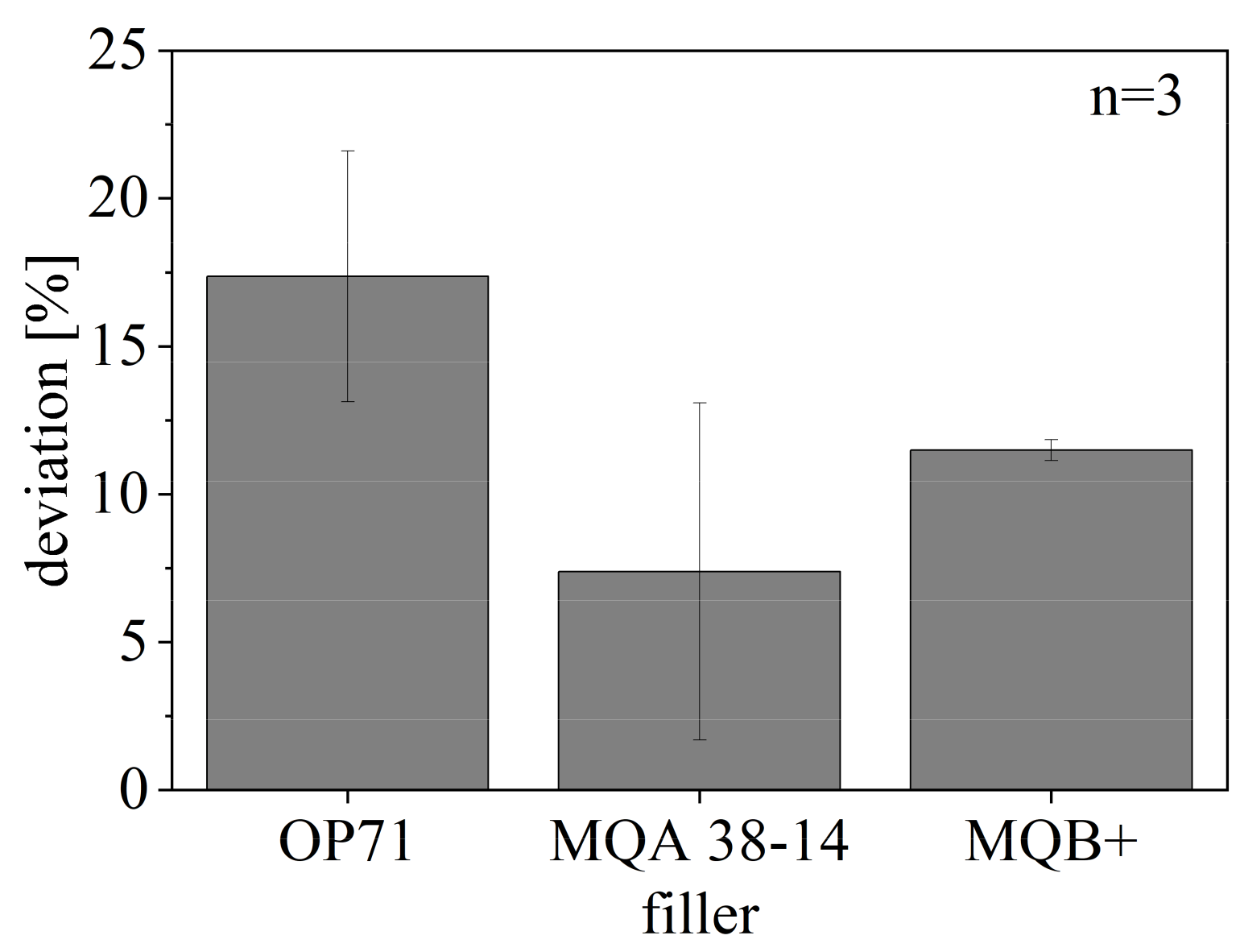

| Filler Material [-] | Isotropy [-] | Type [-] | Mean Particle Size [µm] | Density [g/cm3] | Thermal Conductivity λ [W/(mK)] | Heat Capacity c [J/(gK)] |
|---|---|---|---|---|---|---|
| SrFeO | anisotropic | OP 71 | 1.25 | 5.38 | 7.0 | 0.65 |
| NdFeB | anisotropic | MQA 38-14 | 105 | 7.5 | 9.0 | 0.44 |
| NdFeB | isotropic | MQB + | 250 | 7.63 | 9.0 | 0.44 |
| Mass temperature | 85 °C |
| Mold temperature | 180 °C |
| Holding pressure | 200–400 bar |
| Heating time | 300 s |
| Injection speed | 15 mm/s |
Publisher’s Note: MDPI stays neutral with regard to jurisdictional claims in published maps and institutional affiliations. |
© 2021 by the authors. Licensee MDPI, Basel, Switzerland. This article is an open access article distributed under the terms and conditions of the Creative Commons Attribution (CC BY) license (https://creativecommons.org/licenses/by/4.0/).
Share and Cite
Rösel, U.; Drummer, D. Correlation between the Flow and Curing Behavior of Hard Magnetic Fillers in Thermosets and the Magnetic Properties. Magnetism 2021, 1, 37-57. https://doi.org/10.3390/magnetism1010004
Rösel U, Drummer D. Correlation between the Flow and Curing Behavior of Hard Magnetic Fillers in Thermosets and the Magnetic Properties. Magnetism. 2021; 1(1):37-57. https://doi.org/10.3390/magnetism1010004
Chicago/Turabian StyleRösel, Uta, and Dietmar Drummer. 2021. "Correlation between the Flow and Curing Behavior of Hard Magnetic Fillers in Thermosets and the Magnetic Properties" Magnetism 1, no. 1: 37-57. https://doi.org/10.3390/magnetism1010004







